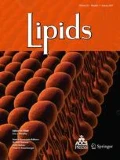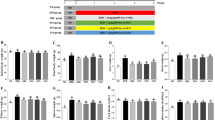Abstract
The effect of dietary cyanidin 3-O-β-d-glucoside (C3G), a typical anthocyanin pigment, on the generation of thiobarbituric acid reactive substances (TBARS) during serum formation ex vivo and susceptibility of serum to further lipid peroxidation was studied in rats. Rats were fed a diet containing C3G (2 g/kg) for 14 d. Feeding C3G resulted in a significant decrease in generation of TBARS during serum formation. The serum from the C3G-fed group showed a significantly lower susceptibility to further lipid peroxidation provoked by 2,2′-azobis (2-amidinopropane)hydrochloride or Cu2+ than that of the control group. No significant differences were observed in serum phospholipid, triglyceride, esterified cholesterol, and free fatty acid concentrations between the control and the C3G-fed groups. Concentrations of endogenous antioxidants remaining in the serum after blood coagulation were not affected by the C3G feeding. These results demonstrate that feeding C3G increases the ex vivo oxidation resistance of the serum without affecting serum endogeneous antioxidant levels, and reduces the TBARS generated during serum formation without changing the concentrations of serum lipids.
Similar content being viewed by others
Abbreviations
- AAPH:
-
2,2′-azobis(2-amidinopropane)hydrochloride
- C3G:
-
cyanidin 3-O-β-d-glucoside
- D3G:
-
delphinidin 3-O-β-d-glucoside
- GSH:
-
reduced glutathione
- LDL:
-
low density lipoprotein
- TBARS:
-
thiobarbituric acid reactive substance
References
Cutler, R.G. (1984) Antioxidants, Aging, and Longevity, in Free Radicals in Biology (Pryor, W.A., ed.) Vol. 6, pp. 371–423, Academic Press, Orlando.
Pryor, W.A. (1986) Cancer and Free Radicals, in Antimutagenesis and Anticarcinogenesis Mechanisms (Shankel, D.M., Hartman, P.E., Kada, T., and Hollaender, A., eds.) pp. 45–59, Plenum Press, New York.
Harman, D. (1992) Free Radical Theory of Aging, Mutat. Res. 275, 257–266.
Stadtman, E.R. (1992) Protein Oxidation and Aging, Science 257, 1220–1224.
Packer, L. (1995) Oxidative Stress, Antioxidants, Aging and Disease, in Oxidative Stress and Aging (Cutler, R.G., Packer, L., Bertram, J., and Mori, A., eds.) pp. 1–14, Birkhäuser Verlag, Basel/Switzerland.
Ames, B.N., Shigenaga, M.K., and Hagen, T.M. (1993) Oxidants, Antioxidants, and the Degenerative Diseases of Aging, Proc. Natl. Acad. Sci. U.S.A. 90, 7915–7922.
Ames, B.N., Caheart, R., Schwiers, E., and Hochstein, P. (1981) Uric Acid Provides an Antioxidant Defense in Humans Against Oxidant-and Radical-Caused Aging and Cancer: A Hypothesis, Proc. Natl. Acad. Sci. U.S.A. 78, 6858–6862.
Simic, M.G. (1988) Mechanisms of Inhibition of Free-Radical Processes in Mutagenesis and Carcinogenesis, Mutat. Res. 202, 377–386.
Meydani, M., Martin, A., Ribaya-Mercado, J.D., Gong, J., Blumberg, J.B., and Russell, R.M. (1994) β-Carotene Supplementation Increases Antioxidant Capacity of Plasma in Older Women, J. Nutr. 124, 2397–2403.
Huang, M.T., and Ferraro, T. (1992) Phenolic Compounds in Food and Cancer Prevention, in Phenolic Compounds in Food and Their Effects on Health II (Huang, M.T., Ho, C.T., and Lee, C.Y., eds.) pp. 8–34, ACS, Washington, D.C.
Osawa, T., Yoshida, A., Kawakishi, S., Yamashita, K., and Ochi, H. (1995) Protective Role of Dietary Antioxidants in Oxidative Stress, in Oxidative Stress and Aging (Cutler, R.G., Packer, L., Bertram, J., and Mori, A., eds.) pp. 367–377, Birkhäuser Verlag, Basel/Switzerland.
Tsuda, T., Ohshima, K., Kawakishi, S., and Osawa, T. (1997) Inhibition of Lipid Peroxidation and Radical Scavenging Effect of Anthocyamin Pigments Isolated from the Seeds of Phaseolus vulgaris L., in Food Factors for Cancer Prevention (Ohigashi, H., Osawa, T., Terao, J., Watanabe, S., and Yoshikawa, T., eds.), pp. 318–322, Springer-Verlag, Tokyo.
Tsuda, T., Makino, Y., Kato, H., Osawa, T., and Kawakishi, S. (1993) Screening for Antioxidative Activity of Edible Pulses, Biosci. Biotech. Biochem. 57, 1606–1608.
Tsuda, T., Ohshima, K., Kawakishi, S., and Osawa, T. (1994) Antioxidative Pigments Isolated from the Seeds of Phaseolus vulgaris L., j. Agric. Food Chem. 42, 248–251.
Tsuda, T., Watanabe, M., Ohshima, K., Norinobu, S., Choi, S.W., Kawakishi, S., and Osawa, T. (1994) Antioxidative Activity of the Anthocyanin Pigments Cyanidin 3-O-β-d-Glucoside and Cyanidin, J. Agric. Food Chem. 42, 2407–2410.
Tsuda, T., Shiga, K., Ohshima, K., Kawakishi, S., and Osawa, T. (1996) Inhibition of Lipid Peroxidation and the Active Oxygen Radical Scavenging Effect of Anthocyanin Pigments Isolated from Phaseolus vulguris L., Biochem. Pharmacol. 52, 1033–1039.
Renaud, S., and Lorgeril, M. (1992) Wine, Alcohol, Platelets, and the French Paradox for Coronary Heart Disease, Lancet 339, 1523–1526.
Frankel, E.N., Kanner, J., German, J.B., Parks, E., and Kinsella, J.E. (1993) Inhibition of Oxidation of Human Low Density Lipoprotein by Phenolic Substances in Red Wine, Lancet 341, 454–457.
Kinsella, J.E., Frankel, E.N., German, B., and Kanner, J. (1993) Possible Mechanisms for the Protective Role of Antioxidants in Wine and Plant Foods, Food Technol. 47, 85–89.
Kondo, K., Matsumoto, A., Kurata, H., Tanahashi, H., Koga, H., Amachi, T., and Itakura, H. (1994) Inhibition of Oxidation of Low Density Lipoprotein with Red Wine, Lancet 344, 1152.
Bakker, J., and Timberlake, C.F. (1985) The Distribution of Anthocyanins in Grape Skin Extracts of Port Wine Cultivars as Determined by High-Performance Liquid Chromatography, J. Sci. Food Agric. 36, 1315–1324.
Bakker, J., and Timberlake, C.F. (1985) The Distribution and Content of Anthocyanins in Young Port Wines as Determined by High-Performance Liquid Chromatography, J. Sci. Food Agric. 36, 1325–1333.
Harborne, J.B., and Grayer, R.J. (1988) The Anthocyanins, in The Flavonoids (Harborne, J.B., ed.) pp. 1–20, Chapman and Hall, London.
Brouillard, R. (1988) Flavonoids and Flower Color, in The Flavonoids (Harborne, J.B., ed.) pp. 525–538, Chapman and Hall, London.
Tsuda, T., Ohshima, K., Kawakishi, S., and Osawa, T. (1996) Oxidation Products of Cyanidin 3-O-β-d-Glucoside with a Free Radical Initiator, Lipids 31, 1259–1263.
Reeves, P.G., Nielsen, F.H., and Fahey, Jr., G.C. (1993) AIN-93 Purified Diets for Laboratory Rodents: Final Report of the American Institute of Nutrition Ad Hoc Writing Committee on the Reformulation of the AIN-76A Rodent Diet, J. Nutr. 123, 1939–1951.
Frei, B., Stocker, R., and Ames, B.N. (1988) Antioxidant Defenses and Lipid Peroxidation in Human Blood Plasma, Proc. Natl. Acad. Sci. U.S.A. 85, 9748–9752.
Gugliucci, A. (1996) Antioxidant Effects of Ilex paraguariensis: Induction of Decreased Oxidability of Human LDL in vivo, Biochem. Biophys. Res. Commun. 224, 338–344.
Naito, C., and Yamanaka, T. (1978) Atherosclerosis and Lipid Hydroperoxides, Nippon Ronenigakukai Zasshi 15, 187–191.
Ohkawa, H., Ohishi, N., and Yagi, K. (1979) Assay for Lipid Peroxides in Animal Tissues by Thiobarbituric Acid Reaction, Anal. Biochem. 95, 351–358.
Ueda, T., and Igarashi, O. (1987) New Solvent System for Extraction of Tocopherols from Biological Specimens for HPLC Determination and the Evaluation of 2,2,5,7,8-Pentamethyl-6-Chromanol as an Internal Standard, J. Micronutr. Anal. 3, 185–198.
Yamamoto, Y., Michael, H.B., Jeffrey, C.B., and Ames, B.N. (1987) Detection and Characterization of Lipid Hydroperoxides at Picomole Levels by High-Performance Liquid Chromatography, Anal. Biochem. 160, 7–13.
Kabasakalian, P., Kalliney, S., and Westcott, A. (1973) Determination of Uric Acid in Serum, with Use of Uricase and a Tribromophenol-Aminoantipyrine Chromogen, Clin. Chem. 19, 522–524.
Takayama, M., Itoh, S., Nagasaki, T., and Tanimizu, I. (1977) A New Enzymatic Method for Determination of Serum Choline-Containing Phospholipids, Clinica. Chimica. Acta 79, 93–98.
Spayd, R.W., Bruschi, B., Burdick, B.A., Dappen, G.M., Eikenberry, J.N., Esders, T.W., Figueras, J., Goodhue, C.T., LaRossa, D.D., Nelson, R.W., Rand, R.N., and Wu, T.W. (1978) Multilayer Film Elements for Clinical Analysis: Applications to Representative Chemical Determinations, Clin. Chem. 24, 1343–1350.
Allain, C.C., Poon, L.S., Chan, C.S.G., Richmond, W., and Fu, P.C. (1974) Enzymatic Determination of Total Cholesterol, Clin. Chem. 20, 470–475.
Duncombe, W.G. (1964) The Colorimetric Micro-Determination of Non-Esterified Fatty Acids in Plasma, Clinica. Chimica. Acta 9, 122–125.
Hertog, M.G.L., Feskens, E.J.M., Hollman, P.C.H., Katan, M.B., and Kromhout, D. (1993) Dietary Antioxidant Flavonoids and Risk of Coronary Heart Disease: the Zutphen Elderly Study, Lancet 342, 1007–1011.
Castelluccio, C., Bolwell, G.P., Gerrish, C., and Rice-Evans, C. (1996) Differential Distribution of Ferulic Acid to the Major Plasma Constituents in Relation to Its Potential as an Antioxidant, Biochem. J. 316, 691–694.
Osawa, T. (1997) Biochemical and Physiological Importance of Plant Polyphenols, in Food Factors for Cancer Prevention (Ohigashi, H., Osawa, T., Terao, J., Watanabe, S., and Yosnikawa, T., eds.) pp. 39–46, Springer-Verlag, Tokyo.
Fuhrman, B., Lavy, A., and Aviram, M. (1995) Consumption of Red Wine with Meals Reduces the Susceptibility of Human Plasma and Low Density Lipoprotein to Lipid Peroxidation, Am. J. Clin. Nutr. 61, 549–554.
Nardini, M., Natella, F., Gentili, V., Felice, M.D., and Scaccini, C. (1997) Effect of Caffeic Acid Dietary Supplementation on the Antioxidant Defense System in Rat: An in vivo Study, Arch. Biochem. Biophys. 342, 157–160.
Author information
Authors and Affiliations
Corresponding author
About this article
Cite this article
Tsuda, T., Horio, F. & Osawa, T. Dietary cyanidin 3-O-β-d-glucoside increases ex vivo oxidation resistance of serum in rats. Lipids 33, 583–588 (1998). https://doi.org/10.1007/s11745-998-0243-5
Received:
Revised:
Accepted:
Issue Date:
DOI: https://doi.org/10.1007/s11745-998-0243-5




